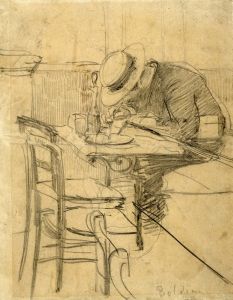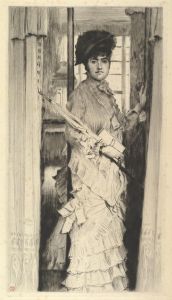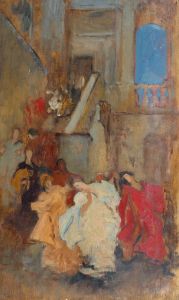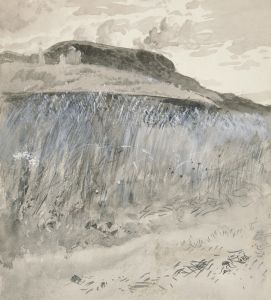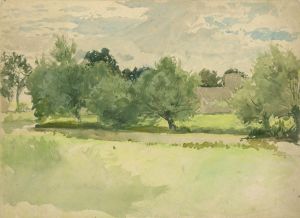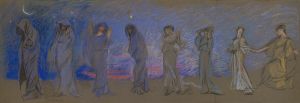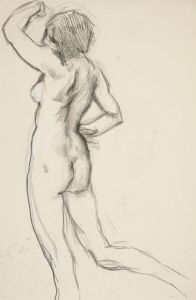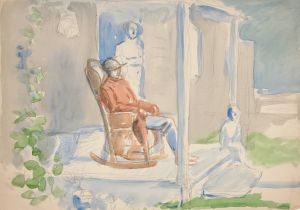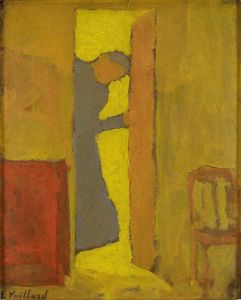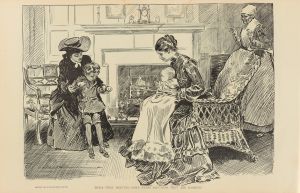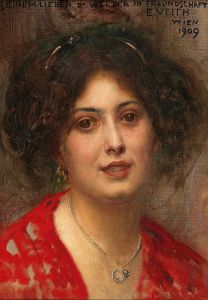
Study of street scene, man at door, woman in red dress.
A hand-painted replica of Edwin Austin Abbey’s masterpiece Study of street scene, man at door, woman in red dress., meticulously crafted by professional artists to capture the true essence of the original. Each piece is created with museum-quality canvas and rare mineral pigments, carefully painted by experienced artists with delicate brushstrokes and rich, layered colors to perfectly recreate the texture of the original artwork. Unlike machine-printed reproductions, this hand-painted version brings the painting to life, infused with the artist’s emotions and skill in every stroke. Whether for personal collection or home decoration, it instantly elevates the artistic atmosphere of any space.
Edwin Austin Abbey was an American artist known for his illustrations and paintings, particularly those depicting scenes from Shakespearean plays and other literary works. He was born on April 1, 1852, in Philadelphia, Pennsylvania, and became a prominent figure in the art world during the late 19th and early 20th centuries. Abbey's work is characterized by its attention to detail, historical accuracy, and a strong narrative quality.
"Study of street scene, man at door, woman in red dress" is one of Abbey's lesser-known works. While there is limited information available specifically about this painting, it is consistent with Abbey's style of capturing everyday life and historical scenes with a keen eye for detail and composition. Abbey often drew inspiration from literature and history, and his works frequently depicted scenes that told a story or captured a moment in time.
Abbey began his artistic career as an illustrator, working for publications such as Harper's Weekly and Scribner's Magazine. His illustrations were well-received, and he gained a reputation for his ability to bring literary scenes to life. Abbey's interest in historical and literary subjects eventually led him to pursue painting, where he continued to explore similar themes.
In the late 19th century, Abbey moved to England, where he became associated with a group of artists known as the "Broadway Group." This group included notable figures such as John Singer Sargent and Lawrence Alma-Tadema. Abbey's time in England was highly productive, and he created some of his most famous works during this period, including his murals for the Boston Public Library and the Pennsylvania State Capitol.
Abbey's work is often noted for its meticulous attention to detail and historical accuracy. He conducted extensive research to ensure that his depictions of historical scenes were as accurate as possible, often studying period costumes, architecture, and artifacts. This dedication to authenticity is evident in many of his works, including "Study of street scene, man at door, woman in red dress."
While specific details about "Study of street scene, man at door, woman in red dress" are scarce, it is likely that the painting reflects Abbey's interest in capturing the essence of a particular moment or scene. The composition, featuring a man at a door and a woman in a red dress, suggests a narrative element, inviting viewers to imagine the story behind the scene. The use of color, particularly the striking red of the woman's dress, adds a focal point and draws the viewer's attention.
Edwin Austin Abbey's contributions to the art world were significant, and his works continue to be appreciated for their narrative quality and historical depth. Although "Study of street scene, man at door, woman in red dress" may not be as widely recognized as some of his other pieces, it exemplifies the qualities that made Abbey a respected and influential artist of his time. Abbey passed away on August 1, 1911, leaving behind a legacy of art that continues to be studied and admired.





